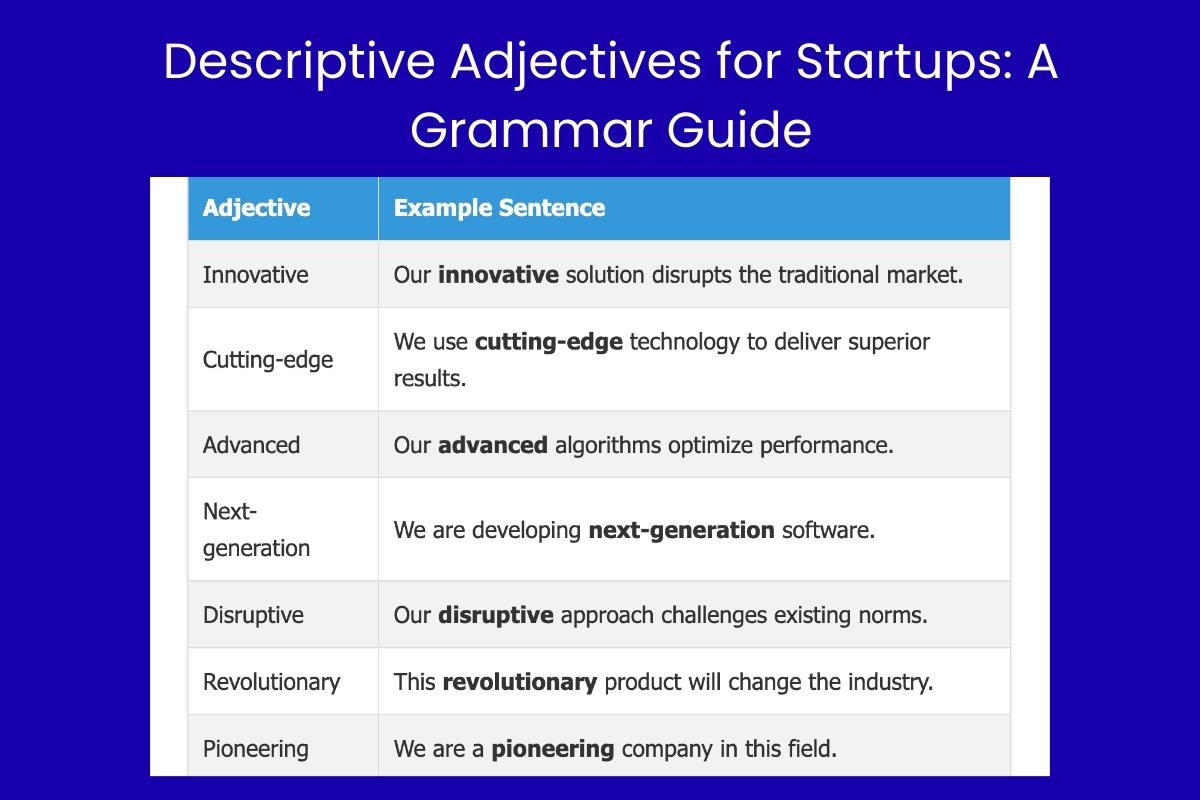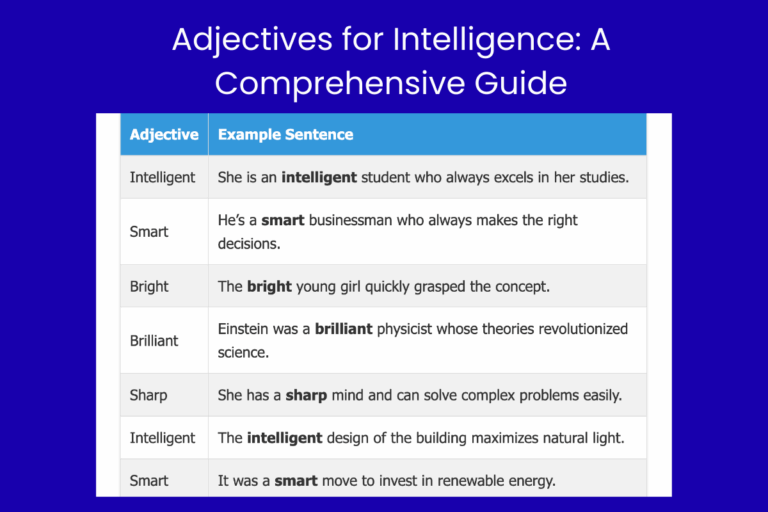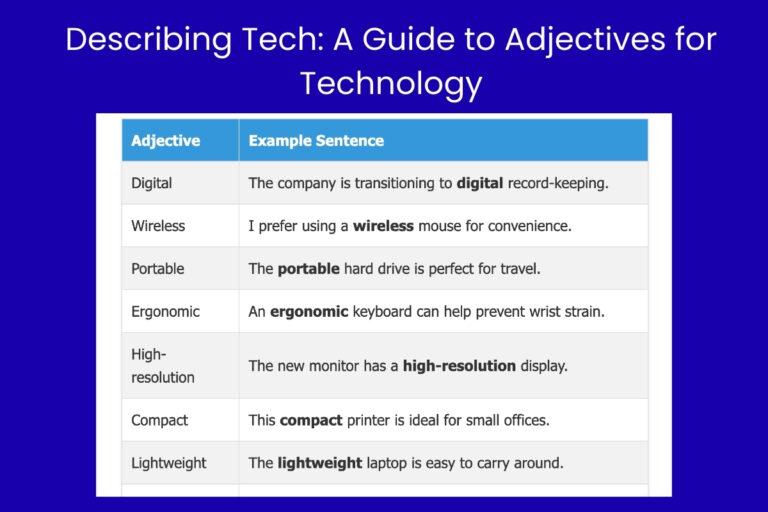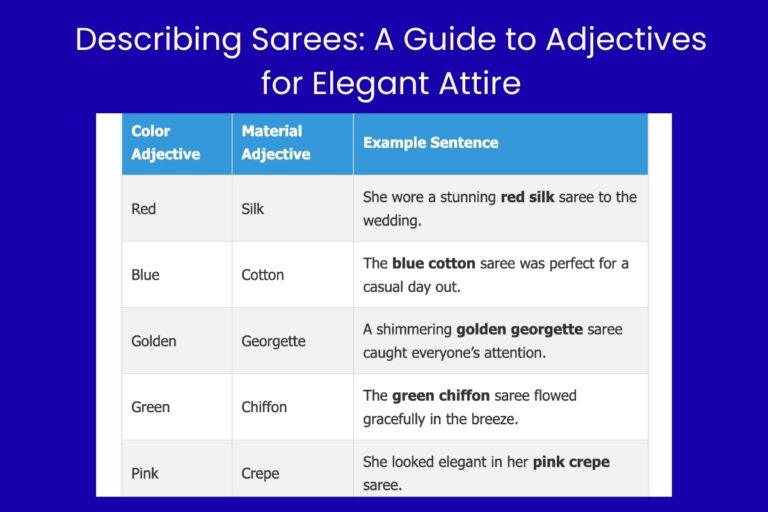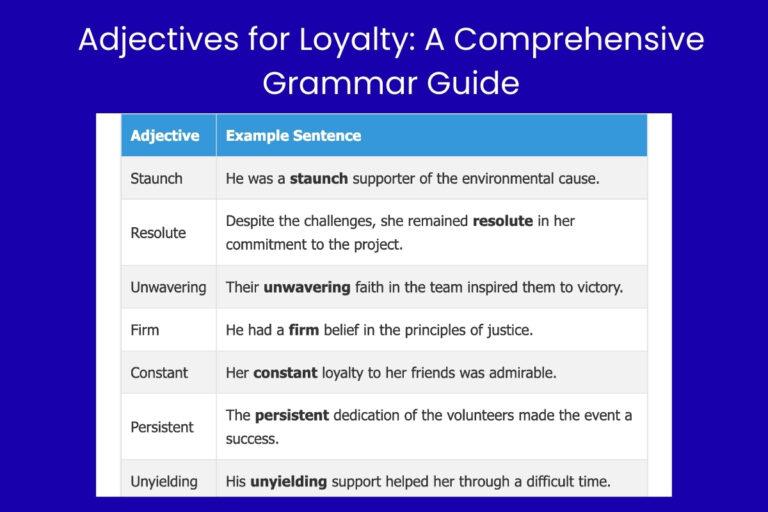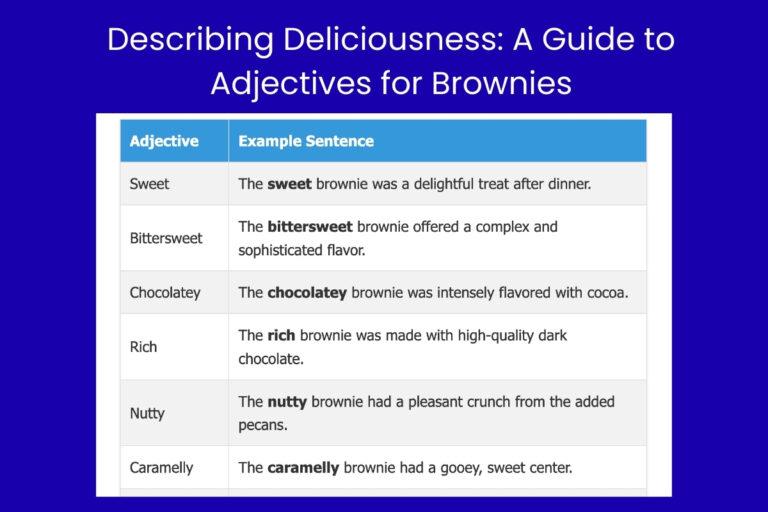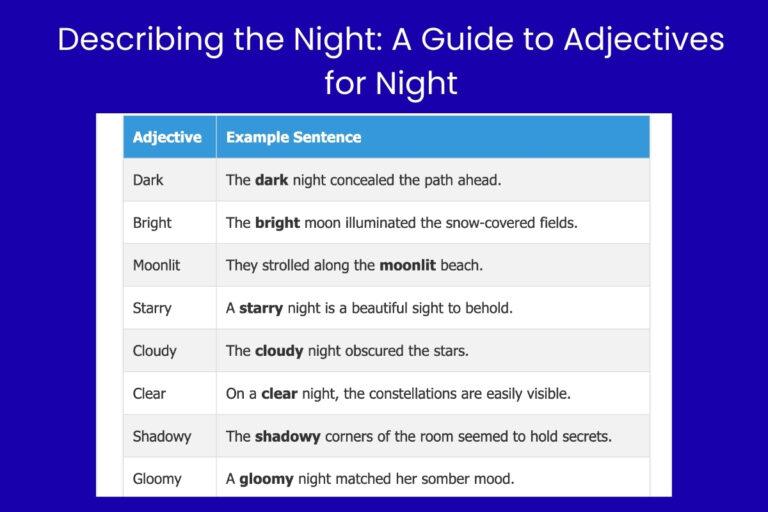Descriptive Adjectives for Startups: A Grammar Guide
In the fast-paced world of startups, clear and impactful communication is crucial. One of the most effective ways to enhance your messaging is through the strategic use of descriptive adjectives. This guide provides a comprehensive overview of adjectives, focusing on how they can be used to define your startup’s brand, values, and unique selling points. Whether you’re crafting marketing materials, pitching to investors, or simply trying to articulate your company’s vision, mastering the art of using descriptive adjectives will significantly improve your communication skills. This article is designed for entrepreneurs, marketing professionals, and anyone involved in the startup ecosystem who wants to refine their language and create a lasting impression.
This article will cover the definition, types, structural rules, usage guidelines, common mistakes, and advanced applications of adjectives relevant to startups. It also includes practice exercises and an FAQ section to help you solidify your understanding. By the end of this guide, you’ll be equipped with the knowledge and tools necessary to use descriptive adjectives effectively and confidently in your startup communications.
Table of Contents
- Definition of Adjectives
- Structural Breakdown of Adjectives
- Types of Adjectives
- Examples of Adjectives for Startups
- Usage Rules for Adjectives
- Common Mistakes with Adjectives
- Practice Exercises
- Advanced Topics: Comparative and Superlative Adjectives
- Frequently Asked Questions (FAQ)
- Conclusion
Definition of Adjectives
An adjective is a word that modifies a noun or pronoun, providing more information about it. Adjectives describe the qualities, characteristics, or attributes of the noun or pronoun they modify. They answer questions like: What kind? Which one? How many? or How much? Adjectives play a crucial role in enriching language, making it more vivid and precise. In the context of startups, well-chosen adjectives can effectively communicate the unique aspects of your company, product, or service.
Function: The primary function of an adjective is to provide additional information about a noun or pronoun. This can include describing its appearance, size, shape, color, origin, or any other attribute that helps to distinguish it from others. Adjectives can also express subjective qualities, such as whether something is good, bad, interesting, or boring.
Contexts: Adjectives are used in various contexts, including:
- Describing products or services: Innovative software, user-friendly interface.
- Defining company culture: Collaborative environment, dynamic team.
- Highlighting unique selling points: Cutting-edge technology, sustainable practices.
- Communicating brand values: Transparent communication, ethical sourcing.
Structural Breakdown of Adjectives
Understanding the structure of adjectives involves recognizing their placement within a sentence and how they interact with other words. Adjectives typically appear before the noun they modify (attributive position) or after a linking verb (predicative position). They can also be modified by adverbs to further refine their meaning.
Attributive Adjectives: These adjectives come directly before the noun they modify. This is the most common placement for adjectives in English.
Example: The innovative startup is gaining traction.
Predicative Adjectives: These adjectives follow a linking verb (such as be, seem, become, appear) and describe the subject of the sentence.
Example: The technology is cutting-edge.
Adjective Order: When using multiple adjectives to describe a noun, there is a general order to follow:
- Opinion: beautiful, interesting
- Size: large, small
- Age: old, new
- Shape: round, square
- Color: red, blue
- Origin: American, Italian
- Material: wooden, metal
- Purpose: writing, cooking
Example: A beautiful large old round blue American wooden table.
Adjective Phrases: An adjective phrase is a group of words that functions as an adjective. It typically includes an adjective and any modifiers, such as adverbs or prepositional phrases.
Example: A highly innovative product. (highly modifies the adjective innovative)
Types of Adjectives
Adjectives can be categorized into several types based on their function and meaning. Understanding these different types can help you choose the most appropriate adjectives for your specific needs.
Descriptive Adjectives
Descriptive adjectives (also known as qualitative adjectives) describe the qualities or characteristics of a noun. They provide information about the appearance, taste, smell, sound, or feel of something. These are the most commonly used adjectives and are essential for creating vivid and engaging descriptions.
Examples: innovative, user-friendly, sustainable, efficient, reliable
Quantitative Adjectives
Quantitative adjectives indicate the quantity or amount of a noun. They answer the question “How many?” or “How much?” These adjectives are useful for providing specific numerical data or general estimations.
Examples: many, few, several, some, all, no
Demonstrative Adjectives
Demonstrative adjectives specify which noun or pronoun is being referred to. They include the words this, that, these, and those. These adjectives help to indicate proximity or distance.
Examples: This product, that strategy, these features, those customers.
Possessive Adjectives
Possessive adjectives indicate ownership or belonging. They include the words my, your, his, her, its, our, and their. These adjectives show who or what owns the noun.
Examples: My company, your feedback, its potential, our vision.
Interrogative Adjectives
Interrogative adjectives are used in questions to ask about a noun. They include the words which and whose. These adjectives help to specify what information is being requested.
Examples: Which product, whose idea?
Examples of Adjectives for Startups
This section provides a variety of examples of adjectives that are commonly used to describe startups, categorized for clarity. These examples can serve as inspiration for your own writing and communication.
Table 1: Adjectives Describing Innovation and Technology
This table showcases adjectives that highlight a startup’s cutting-edge approach and technological prowess.
| Adjective | Example Sentence |
|---|---|
| Innovative | Our innovative solution disrupts the traditional market. |
| Cutting-edge | We use cutting-edge technology to deliver superior results. |
| Advanced | Our advanced algorithms optimize performance. |
| Next-generation | We are developing next-generation software. |
| Disruptive | Our disruptive approach challenges existing norms. |
| Revolutionary | This revolutionary product will change the industry. |
| Pioneering | We are a pioneering company in this field. |
| State-of-the-art | Our facilities are equipped with state-of-the-art equipment. |
| Tech-savvy | Our team is tech-savvy and always up-to-date. |
| Modern | We offer modern solutions for today’s challenges. |
| Futuristic | Our designs are futuristic and forward-thinking. |
| Automated | We provide automated solutions to streamline processes. |
| Digital | We offer digital marketing services. |
| Virtual | We offer virtual assistant services. |
| Smart | We are developing smart home technology. |
| Algorithmic | Our algorithmic approach ensures precision. |
| Cybernetic | We’re at the forefront of cybernetic innovation. |
| Robotic | We specialize in robotic automation. |
| High-tech | We are a high-tech startup. |
| Computerized | Our processes are fully computerized. |
| Electronic | We manufacture electronic components. |
| Networked | Our systems are fully networked. |
| Wireless | We offer wireless solutions. |
Table 2: Adjectives Describing Company Culture and Values
This table focuses on adjectives that reflect the internal environment and guiding principles of a startup.
| Adjective | Example Sentence |
|---|---|
| Collaborative | We foster a collaborative work environment. |
| Dynamic | Our team is dynamic and adaptable. |
| Agile | We use agile methodologies to stay flexible. |
| Inclusive | We are committed to creating an inclusive workplace. |
| Transparent | We believe in transparent communication. |
| Ethical | We adhere to ethical business practices. |
| Sustainable | We are dedicated to sustainable development. |
| Resilient | Our team is resilient in the face of challenges. |
| Passionate | We are passionate about our mission. |
| Dedicated | Our team is dedicated to customer satisfaction. |
| Empowering | We are an empowering company. |
| Innovative | We have an innovative culture. |
| Creative | We encourage a creative environment. |
| Supportive | We provide a supportive workplace. |
| Open-minded | Our team is open-minded and welcoming. |
| Driven | We are a driven team. |
| Goal-oriented | We are goal-oriented and focused. |
| Results-driven | We are a results-driven company. |
| Fast-paced | We thrive in a fast-paced environment. |
| Energetic | We are an energetic team. |
| Visionary | We are visionary and forward-thinking. |
| Ambitious | We are an ambitious startup. |
| Growth-oriented | We are a growth-oriented company. |
Table 3: Adjectives Describing Product Qualities
This table highlights adjectives that can be used to describe the attributes and benefits of a startup’s products or services.
| Adjective | Example Sentence |
|---|---|
| User-friendly | Our software has a user-friendly interface. |
| Efficient | Our process is efficient and saves time. |
| Reliable | Our services are reliable and trustworthy. |
| Affordable | We offer affordable solutions for small businesses. |
| Scalable | Our platform is scalable and can grow with your needs. |
| Versatile | Our product is versatile and adaptable. |
| Durable | Our products are durable and long-lasting. |
| Effective | Our methods are effective and produce results. |
| Secure | Our systems are secure and protect your data. |
| Seamless | Our integration is seamless and hassle-free. |
| Intuitive | Our design is intuitive and easy to use. |
| Simplified | We offer simplified solutions. |
| Streamlined | Our processes are streamlined and efficient. |
| Customizable | Our products are fully customizable. |
| Personalized | We offer personalized service. |
| Comprehensive | We offer comprehensive support. |
| Integrated | Our systems are fully integrated. |
| Modular | We offer modular solutions. |
| Turnkey | We provide turnkey solutions. |
| All-in-one | We offer an all-in-one platform. |
| High-quality | We offer high-quality products. |
| Premium | We offer premium services. |
| Value-added | We offer value-added services. |
Table 4: Adjectives Describing Market Position and Growth
This table showcases adjectives that convey a startup’s strength, potential, and impact in the market.
| Adjective | Example Sentence |
|---|---|
| Emerging | We are an emerging leader in the industry. |
| Fast-growing | We are a fast-growing company. |
| Leading | We are a leading provider of these services. |
| Dominant | We aim to become a dominant player in the market. |
| Successful | We have a successful track record. |
| Promising | We are a promising startup with great potential. |
| Impactful | Our work is impactful and makes a difference. |
| Influential | We are an influential force in the industry. |
| Competitive | We offer competitive pricing. |
| Global | We are a global company. |
| International | We have an international presence. |
| National | We are a national leader. |
| Regional | We are a regional player. |
| Local | We are a local business. |
| Established | We are an established company. |
| Growing | We are a growing business. |
| Rising | We are a rising star. |
| Major | We are a major player. |
| Strategic | We have a strategic advantage. |
| Dynamic | We are a dynamic competitor. |
Table 5: Adjectives Describing Financial Aspects
This table focuses on adjectives that highlight the financial health and viability of a startup.
| Adjective | Example Sentence |
|---|---|
| Profitable | We are a profitable company. |
| Financially stable | We are financially stable and secure. |
| Well-funded | We are a well-funded startup. |
| Sustainable | We have a sustainable business model. |
| Lucrative | This is a lucrative market opportunity. |
| Viable | Our business plan is viable and realistic. |
| Cost-effective | Our solutions are cost-effective. |
| Efficient | We have an efficient capital structure. |
| Economical | Our solutions are economical. |
| Budget-friendly | We offer budget-friendly options. |
| Affordable | We provide affordable services. |
| Low-cost | We offer low-cost solutions. |
| High-value | We offer high-value services. |
| Valuable | We provide valuable insights. |
| Sound | We have a sound financial strategy. |
| Robust | We have a robust financial model. |
| Healthy | We have a healthy cash flow. |
| Solid | We have a solid financial foundation. |
| Growing | We have growing revenues. |
| Increasing | We have increasing profits. |
Usage Rules for Adjectives
Proper usage of adjectives involves understanding their placement, order, and agreement with the nouns they modify. Adhering to these rules ensures clarity and grammatical correctness in your writing.
Placement: As mentioned earlier, adjectives typically precede the noun they modify (attributive) or follow a linking verb (predicative).
- Attributive: The innovative product.
- Predicative: The product is innovative.
Order: When using multiple adjectives, follow the general order of adjectives (opinion, size, age, shape, color, origin, material, purpose).
Correct: A beautiful large old building.
Incorrect: A large old beautiful building.
Agreement: Adjectives in English do not change form to agree with the number or gender of the noun they modify. This is different from many other languages where adjective agreement is required.
Correct: The innovative product, The innovative products.
Coordinate Adjectives: Coordinate adjectives are two or more adjectives that equally modify the same noun. They are separated by a comma or the word “and.” Coordinate adjectives should be able to be reversed in order without changing the meaning of the sentence.
Example: The startup has a dynamic, collaborative culture. (You could also say “collaborative, dynamic” without changing the meaning.)
Cumulative Adjectives: Cumulative adjectives build upon each other to modify the noun. They should not be separated by a comma, and their order matters.
Example: A fast-growing tech company. (You wouldn’t say “tech fast-growing” company.)
Common Mistakes with Adjectives
Avoiding common mistakes with adjectives can significantly improve the clarity and accuracy of your writing. Here are some frequent errors and how to correct them:
Misplaced Adjectives: Placing an adjective in the wrong position can lead to confusion or unintended meanings.
Incorrect: The report was submitted late about the project.
Correct: The late report about the project was submitted.
Incorrect Order of Adjectives: Using the wrong order of adjectives can sound awkward or unnatural.
Incorrect: A red big car.
Correct: A big red car.
Using Adjectives as Adverbs: Confusing adjectives with adverbs is a common error, especially with words that have similar forms.
Incorrect: The company performed good this year.
Correct: The company performed well this year. (Well is the adverb form of good.)
Double Negatives: Using two negative words in a sentence can create a positive meaning or cause confusion.
Incorrect: The product is not unreliable.
Correct: The product is reliable.
Incorrect Comparative/Superlative Forms: Making errors with the comparative and superlative forms of adjectives is a common mistake. Make sure to use the correct suffixes (-er, -est) or the words “more” and “most” as appropriate.
Incorrect: This product is more better than that one.
Correct: This product is better than that one.
Practice Exercises
Test your understanding of adjectives with these practice exercises. Identify the adjectives in each sentence and classify their type. Then, correct any sentences with errors in adjective usage.
Exercise 1: Identifying Adjectives
Identify the adjectives in the following sentences.
| Question | Answer |
|---|---|
| 1. The innovative startup is gaining market share. | innovative |
| 2. Our user-friendly interface makes navigation easy. | user-friendly |
| 3. We offer sustainable solutions for the future. | sustainable |
| 4. This product is more efficient than the previous model. | efficient, previous |
| 5. Several investors showed interest in our company. | several |
| 6. Which strategy will be most effective? | effective |
| 7. My vision is to create a better world. | My, better |
| 8. Those customers are very satisfied with our services. | Those, satisfied |
| 9. This is a collaborative environment. | collaborative |
| 10. We have a dedicated team. | dedicated |
Exercise 2: Correcting Adjective Errors
Correct the errors in the following sentences related to adjective order, placement, or form.
| Question | Answer |
|---|---|
| 1. The presentation was very good. | The presentation was very good. (Correct) |
| 2. A car red big. | A big red car. |
| 3. This is the most best product we offer. | This is the best product we offer. |
| 4. The company performed good this quarter. | The company performed well this quarter. |
| 5. An environment collaborative dynamic. | A dynamic, collaborative environment. |
| 6. The report late was submitted. | The late report was submitted. |
| 7. This is a solution innovative new. | This is an innovative new solution. |
| 8. The product is not unexpensive. | The product is inexpensive. |
| 9. The team is very motivate. | The team is very motivated. |
| 10. Our services are reliable and efficiency. | Our services are reliable and efficient. |
Exercise 3: Using Descriptive Adjectives
Fill in the blanks with appropriate descriptive adjectives to describe the following aspects of a startup.
| Question | Answer |
|---|---|
| 1. Our company has a very __________ culture. | Our company has a very collaborative culture. (Example) |
| 2. We offer __________ solutions to complex problems. | We offer innovative solutions to complex problems. |
| 3. Our team is __________ and always ready for new challenges. | Our team is dynamic and always ready for new challenges. |
| 4. We are committed to __________ business practices. | We are committed to ethical business practices. |
| 5. Our products are known for their __________ design. | Our products are known for their user-friendly design. |
| 6. We are a __________ company with a bright future. | We are a promising company with a bright future. |
| 7. Our __________ support team is always available to help. | Our dedicated support team is always available to help. |
| 8. This technology is truly __________. | This technology is truly revolutionary. |
| 9. Our __________ approach sets us apart from the competition. | Our unique approach sets us apart from the competition. |
| 10. We provide __________ services that deliver real results. | We provide effective services that deliver real results. |
Advanced Topics: Comparative and Superlative Adjectives
Understanding comparative and superlative adjectives allows you to make comparisons and express degrees of quality. This is particularly useful for highlighting the advantages of your startup’s products or services.
Comparative Adjectives: These adjectives compare two nouns. They are formed by adding “-er” to the end of the adjective (if it’s a short word) or by using “more” before the adjective (if it’s a longer word).
Examples: faster, more efficient
Example Sentence: Our software is faster than the competition’s.
Superlative Adjectives: These adjectives compare three or more nouns and indicate the highest degree of quality. They are formed by adding “-est” to the end of the adjective (if it’s a short word) or by using “most” before the adjective (if it’s a longer word).
Examples: fastest, most efficient
Example Sentence: Our software is the most efficient on the market.
Irregular Comparative and Superlative Forms: Some adjectives have irregular comparative and superlative forms.
- Good: better, best
- Bad: worse, worst
- Far: farther/further, farthest/furthest
Using “than” and “as…as”: When using comparative adjectives, use “than” to indicate what you are comparing to. Use “as…as” to indicate equality.
Example: Our product is more reliable than theirs.
Example: Our product is as user-friendly as theirs.
Frequently Asked Questions (FAQ)
This section addresses common questions about using adjectives, providing clear and concise answers to help you improve your grammar skills.
Q1: What is the difference between an adjective and an adverb?
A: An adjective modifies a noun or pronoun, while an adverb modifies a verb, adjective, or another adverb. Adjectives describe nouns, while adverbs describe how, when, where, or to what extent an action is performed. For example, “the fast car” (fast is an adjective describing the car) vs. “the car drove fast” (fast is an adverb describing how the car drove).
Q2: Can I use multiple adjectives to describe a single noun?
A: Yes, you can use multiple adjectives, but it’s important to follow the correct order of adjectives. Generally, the order is opinion, size, age, shape, color, origin, material, and purpose. Using the correct order makes your writing sound more natural and fluent.
Q3: Do adjectives change form based on the noun they modify?
A: No, adjectives in English do not change form to agree with the number or gender of the noun they modify. This is unlike some other languages where adjective agreement is a key grammatical rule. In English, the adjective remains the same regardless of whether the noun is singular or plural.
Q4: How do I know when to use “more” or “-er” for comparative adjectives?
A: Generally, use “-er” for short adjectives (one or two syllables) and “more” for longer adjectives (three or more syllables). However, there are exceptions. When in doubt, listen to what sounds more natural. For example, “faster” sounds better than “more fast,” while “more beautiful” sounds better than “beautifuller.”
Q5: What are some common mistakes to avoid when using adjectives?
A: Common mistakes include using adjectives as adverbs, misplacing adjectives in a sentence, using the incorrect order of adjectives, and making errors with comparative and superlative forms. Reviewing these common errors can help you improve your grammar skills.
Q6: How can I improve my vocabulary of descriptive adjectives?
A: To improve your vocabulary, read extensively, pay attention to the adjectives used by skilled writers, and make a conscious effort to incorporate new adjectives into your own writing and speaking. Using a thesaurus can also help you find synonyms for common adjectives, adding variety and precision to your language.
Q7: What is the difference between coordinate and cumulative adjectives?
A: Coordinate adjectives modify the noun equally and can be rearranged without changing the sentence’s meaning; they are separated by commas (e.g., “a smart, innovative design”). Cumulative adjectives build upon each other, and their order matters; they are not separated by
commas (e.g., “a fast-growing tech company”).
Conclusion
Mastering the use of adjectives is essential for effective communication in the startup world. By understanding the different types of adjectives, their structural rules, and common pitfalls, you can significantly enhance your ability to describe your company, products, and vision. Strategic use of descriptive adjectives not only clarifies your message but also adds depth and persuasiveness, making your communications more impactful. As you continue to refine your language skills, remember to practice regularly and pay attention to the nuances of adjective usage. Whether you’re crafting marketing materials, pitching to investors, or defining your brand, the right adjectives can help you create a lasting impression and achieve your goals.
